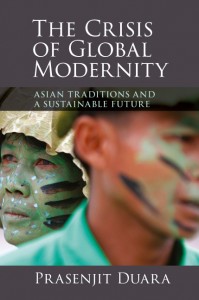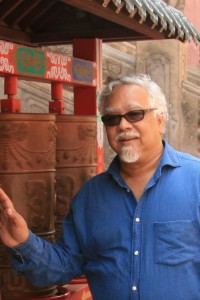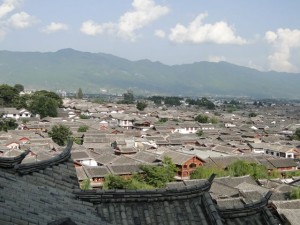Prasenjit Duara’s The Crisis of Global Modernity: Asian Traditions and a Sustainable Future (Cambridge University Press, 2015)
 is a wide-ranging overview of Asian environmental history and philosophy. A singularly timely publication, it is a hugely important intervention in the global discussion of climate change.
is a wide-ranging overview of Asian environmental history and philosophy. A singularly timely publication, it is a hugely important intervention in the global discussion of climate change.
Prasenjit Duara is singularly well equipped for this ambitious undertaking. Assamese by birth, he was educated at Delhi University and Harvard, and was for many years a professor of Chinese history at the University of Chicago (he also taught briefly at Delhi University where, I am proud to say, I was one of the many undergraduates who hung upon his words). He is currently the Raffles Professor of the Humanities at the National University of Singapore and also the director of the university’s Asian Research Institute. Fluent in Japanese, Mandarin and several other languages, Duara is the author of many books and articles in East Asian history, among them the ground-breaking study Sovereignty and Authenticity: Manchukuo and the East Asian Modern.
Crisis of Global Modernity is thus founded upon a lifetime of scholarship, in diverse fields: it is at once a magisterial tour de horizon of many centuries of Asian thought, and also a provocative meditation on the resources that Asian traditions can offer to a world in which the dominant models of economy and governance have proved catastrophically dysfunctional.
Through his scholarly career, nationalism and the nation-state have been among Duara’s central concerns. In Crisis of Global Modernity he identifies the institution of the nation state as one of the prime drivers of the present crisis.
In the post-Cold War era, the growing collusion between transnational capital and the nation-state means that the latter is not as capable of protecting the interests of the community and the natural world in their territories. Not only are many national institutions diverted from promoting public services and protecting the commons, profit-driven economic globalization has wreaked environmental degradation across the world that can hardly be addressed only by national policies. The growing economic interdependence of the world requires the political and cultural authority to be able to manage and regulate it. Global sustainability requires a cosmopolitanism that is able to transcend the nation. (241)
He then proceeds to identify several domains of cosmopolitanism that could serve to overcome national divisions and inter-state rivalries in Asia. Among them are maritime and mercantile connections:
The Asian maritime networks of the pre-colonial era … involved a wide variety of merchant communities at different points who did not speak the same languages or trade in the same currencies… In many ways, contemporary Asian regional interdependence resembles the maritime Asian trade networks, because of the separation of political, economic and military levels and power…. Although the actual products flowing through the Asian maritime networks were miniscule compared to today’s figures, the cultural flows they enabled–packaged in Hinduism, Buddhism, Confucianism, Daoism, Islam—were nothing short of world-transforming… Nonetheless, the older Asian models of cultural circulation without state domination of identity presents us with a historical resource to explore new possibilities. (277)
Duara finds reason for optimism also in regional economic groupings, ASEAN in particular.
[T]he quickening pace of ASEAN integration has spawned a vast and vibrant space of civil society including those sponsored by ASEAN administration and those committed to an ‘alternative’ or ‘people-centered ASEAN.’ At any rate, the development of the region not only furnishes a wider framework to observe and manage the problem of the commons, it also provides opportunities for alliances and networking across a diverse region with a variety of informational and organizational resources. (273)
In the growth of trans-Asian cultural connections Duara identifies yet another promising trend.
There is some indication of greater cultural interest of Asians in Asia. We see this in the increase in the number of tourists circulating the region to over pre-crisis levels. Not only has the market demand for Asian art sky-rocketed, but there are plenty of exhibitions and showings of Asian art in which artists and curators experiment with new ideas of Asia as well as art. These shows often deliberately distance themselves from the culturally unified notion of Asia or reified versions of national civilizations prevalent among their predecessors like Okakura and Nand Lal Bose. They often seek to showcase the contemporary, urban multi-cultural experience of Asia emphasizing heterogeneity and cultural encounters. At a popular level, the circulation of East Asian cinema, manga, anime, TV shows, food, design and allied areas in East and Southeast Asia have been the most conspicuous cultural development in Asia since the 1990s. (256)

Among the most interesting chapters of Crisis of Global Modernity is one that provides an overview of contemporary environmental movements across Asia. Some of these, such as India’s Chipko and Narmada Dam movements, have been extensively chronicled.
It is the material on environmental movements in China that comes as a real surprise: here again Duara paints a picture quite different from those we usually see.
[W]hile the daily news is filled with small and large environmental disasters, China has also witnessed some remarkable developments in the environmental sphere. Among all developing countries, the Chinese government’s efforts in environmental education are probably the greatest. In 2007, President Hu Jintao coined the idea of Ecological Civilization through which he sought to replace economic construction as the core of development with sustainable development that must incorporate a balanced relationship between humans and nature. The central government in China has been steadily developing the institutional and financial infrastructure of environmental protection. In 2005, China raised its expenditure for environmental protection in the national budget to 1.4% of GDP and in 2008, the State Environmental Protection Agency was given full ministerial status and established local environmental protection branches all over the country. (35-36)
Over the last twenty years, environmental NGOs or ENGOs as well as informal groups and movements have mushroomed across the country. Indeed, Guobin Yang and Craig Calhoun have dubbed this activism as the “green public sphere” in China. According to the government affiliated… All China Environmental Federation, in 2008, there were 2768 ENGOs (employing 224,000), which rose to almost 8,000 in 2013. . There are many thousands of others which are not formally registered as ENGOs. Their role has been enhanced by recognition at higher levels of government for the environmental services they can render such as enhancing environmental consciousness among the public and mobilizing for projects like reforestation. More importantly, they are able to serve as watchdogs to expose the violation or non-implementation of environmental laws. Of course, as civic organizations in the PRC, they occupy a vulnerable status and most organizations are careful not to oppose state policies, but serve rather in a vital ‘supplementary’ role as pressure groups, guardians and enablers for the victimized. (36)
Nonetheless, ENGOs have been perhaps unexpectedly successful in influencing state policies over the last decade—until very recently. A landmark event for Chinese environmental history was the halting—or shelving– of the massive Nu River Dam projects in 2004 … The event was important for various reasons, including the collective action taken not only by the Chinese groups, but with international NGOS and groups and governments in Southeast Asian countries that would have been affected by the enormous environmental impact on their societies. The Chinese groups also ignited the media campaign– including both the old and new media—that launched the vigorous ‘green public sphere’ and ‘greenspeak’ which is remarkably continuous with the global green discourse of climate change, sustainable consumption, bio-diversity, desertification, etc. (37)
The profile of activists and activities of the ENGOs suggests an orientation that transcends consumerist and materialist approaches to life, at least among the youth for the time being. Bao Maohong notes that eighty percent of the staff of the registered ENGOs is under thirty and although over half of them have college degrees, they are motivated by their mission rather than their rather paltry, if any, salaries. Greenspeak tends to promote a new moral-spiritual/religious vision and practices and promotes volunteerism and civil participation in opposition to materialist and consumerist practices. The All China Environmental Federation notes that 70% of the public surveyed by it recognized and supported the activities of the ENGOs. (37)
[T]here are some interesting experiments in environmental education among grass-roots environmental NGOs,

especially in Yunnan, a province rich in bio-diversity and called the “cradle of NGOs.”
Robert Erfid’s study of NGOs working in the Naxi region of Lijiang and particularly Lashihai shows how some of these small,

shoe-string budget NGOs committed to environmental education have sought, not merely to tailor environmental learning to local circumstances, but also to engage children in a practical, hands-on education with the environment. (38)
Although Crisis of Global Modernity teems with detail, Duara’s fundamental concern is not with the nitty-gritty of historical and social analysis. The book’s essential engagement (and this perhaps is its greatest surprise) is with what Duara calls ‘transcendence’. By this he means
a way of human knowing based upon an inscrutable yearning or calling with several attributes that coexist in varying degrees. It is a critique of existing conditions that draws on a non-worldly moral authority. (6)
The domain that Duara is gesturing at is that of religious and spiritual tradition: these, he seems to suggest, are Mankind’s last best hope for tackling the climate crisis.
Much of this book has dealt with the descriptions and expressions of … a reaching beyond the self that is not committed to a single all-powerful God, truth or eschaton. Dialogue involves incrementalism and negotiation between local needs and universal requirements and is intertwined with ideals from the living historical repertoire that can engage the changing requirements of the present. Its value today will lie in the capacity to create a sustainable ideal which much of the world can endorse. The second requirement is the capacity of culture to create personal and collective commitment, a problem of hope and sacrality. [282]
… Modern universalisms have tended to lack confidence in investing the transcendent or utopian truths they propose with symbols and rituals of sacred authority. Their hesitation doubtless has good reasons that we may see from the rampaging power of extreme nationalisms, such as Nazism, or blinding faith in utopian science triumphant over reason. But no movement of major social change has succeeded without a compelling symbology and affective power. [282]
Working with the Abrahamic religions, Ricoeur identifies faith, hope and the sacred as a primordial complex identified with ‘manifest communities’ founded on numinous and preverbal experiences of the sacred in nature before they become book-centered, interpretive, intratribal and iconoclastic ‘proclamation communities’. At the same time, he does not believe that interpretive reason or kerygmatic logic can negate the primordial sacred. Rational exposition and logical interpretation derive from and are dependent upon the symbolism of the sacred, say, the figure of Christ; but, just as much, they are necessary for the sacred. From this he argues that the task of contemporary interpreters and philosophers of religion is to rationally explicate such figures of hope in a contemporary world of injustice and suffering. (283)
In the course of writing this book, I began to wonder if the thorny task of mediating the sacred with reason could be eased if we can recognize that the gap between ideal, project, and effort and its realization may be occupied not principally by faith or belief, but by hope. Consider some of the cases I discussed in the book where reverence and reason were inseparably entwined with hope. (284)
Whether by the Confucian sage or the laywomen of the Morality Society, Tian and Dao were viewed as the source and highest judge of the ethical mission for humans. Yet, neither Heaven nor the Way is anthropomorphic like an all-powerful God with a clear and singular message, and failure to follow its path – by this time in Chinese history – does not result in punishment either immediately or in the afterlife. The sacrality of Heaven was intertwined with reason and hope; indeed, the ambiguities of Heaven’s message ironically subjected it to rational deliberation and empirical persuasion… (284)
Similarly, the environmental, rural reconstructionist and moral (anticorruption) movements inspired by Gandhianism draw on a complex matrix of goals and methods. Their moral authority derives significantly from Gandhi – his message, goals, methods, life and the movement he spawned – as a figure of hope … (284)
The perspective of Crisis of Global Modernity is thus post-secular and post-national: Duara recognizes that the climate crisis has indeed changed everything and that it is futile to attempt to engage with it through the 19th and 20th century frameworks of economy and governance that created it in the first place.
